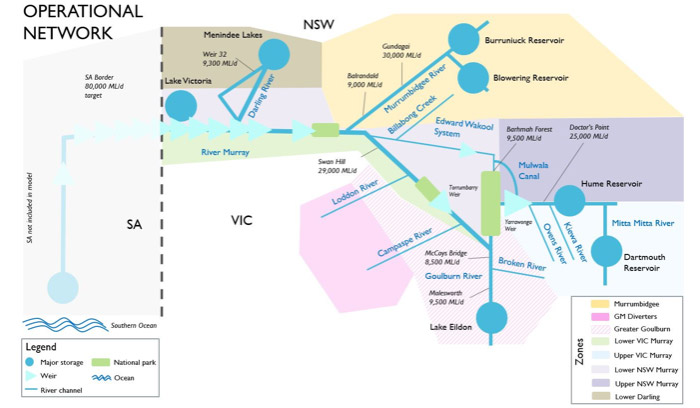Forecasts to recoup more value from water resources
Improving the accuracy of water supply and demand forecasts to provide more precise water deliveries through Australia’s river systems is expected to add millions of dollars to the value of irrigated agriculture and to enhance environmental outcomes.
Professor QJ Wang is leading the University of Melbourne’s involvement in this three-year water forecasting project, which he says will benefit both consumptive uses, such as irrigation, and environmental water deliveries.
It is driven by the need to better manage water resources, given the extreme variation in Australia’s rainfall from year to year. Water managers and users are left with large levels of uncertainty in water availability and demand at annual, seasonal and sub-seasonal timescales.
Professor Wang says the ability of water managers to respond to this uncertainty is heavily dependent on the quality and reliability of climate and water forecasts, as well as the level of sophistication in the decision-support tools available to them.
The aim of the current project is to improve available decision-support tools. It will build on more than a decade of research and investment in precipitation forecasts and hydrological modelling for streamflow forecasts, which are now provided by the Bureau of Meteorology.
These forecasts have been welcomed by the water sector and are being used mostly as qualitative information for decision-making. Professor Wang however, believes they have not been used to their full capacity.
One reason for the delayed uptake is that the streamflow forecasts have a three-month outlook and are often based on monthly data from water storages. Neither of these timescales integrates well with the actual modelling and planning programs that water agencies currently use to make allocation and delivery decisions.
However, the new modelling will extend forecasts to 12 months, and include daily data to better align with the water agency needs. This will provide a quantitative approach for more accurate planning of water availability and deliveries. This, in turn, has the potential to unlock increased value from water, which traded on the temporary market for almost $1000 per megalitre in early 2020.
The Bureau of Meteorology is a collaborator in the project, along with the Murray–Darling Basin Authority, the NSW Department of Planning, Industry and the Environment, and Victoria’s Goulburn-Murray Water and Lower Murray Water Goulburn. Other partners are CSIRO and the European Centre for Medium-Range Weather Forecasts.
Improved irrigation decisions
From an irrigation perspective, Professor Wang says current water allocation announcements come with monthly outlooks that indicate what allocations might be, given a range of different stream inflow conditions.
But it basically leaves irrigators to ‘bet’ on what they think the inflows will be, and to carry all the risk,
he says. We can do much better than that.
As water authorities, Goulburn-Murray Water and NSW Department of Planning, Industry and the Environment are crucial partners in the project, helping to bring together diverse data sources to provide probabilistic forecasts for allocations across the year.

Professor Wang says to date, modelling and forecasts have focused largely on the supply side of the water equation, but this project will expand to also include water demand. This will incorporate annual climatic information with localised and daily weather and evaporation data.
Meeting demand
If we can help water agencies use forecasts to better manage their water, we can also provide more information with greater confidence to water markets, which can be used to support trading decisions.
Improved demand management forecasts will also help to improve the movement of water between catchments and storages for use throughout the irrigation season, and for environmental outcomes.

Professor Wang says that with better demand estimates, water can be moved between different storages at the most appropriate times to avoid the need for high flows that could result in transmission losses and the unseasonal watering of wetlands.
Supply and demand forecasts combined could also help prevent water spilling from storages that are already full when subsequent inflows occur, such as those following a major rain event.
The highest priority for us is to predict where the water use is going to be, so we can help make decisions about moving water around,
Professor Wang says.
Governments have a lot of environmental water that also competes with consumptive water, in terms of what the river can actually transport. Again, with forecasting, you can actually do a much better job of meeting demand at the right time, minimising unwanted impacts.
The ‘Water availability and demand: better forecasts, better management’ project began in 2019, and is expected to deliver new forecasting options for water agencies by 2022.